Ageing and sexing details:
|
JAN - JUL: after-second-year
male |
ASY
males are usually jet black with prominent and red/orange and yellow
epaulettes.
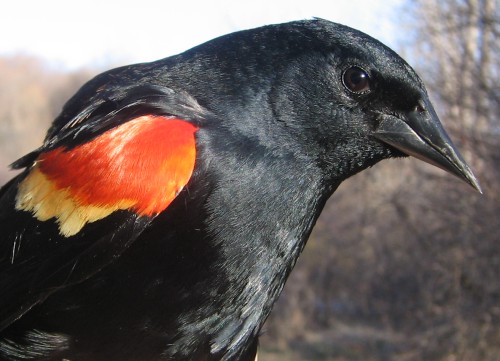
Photo by Marie-Anne Hudson,
McGill Bird Observatory (QC), April 2006
The
epaulettes, or shoulders, in an ASY M contain no trace of black. They
are solidly bright red or orange and yellow.
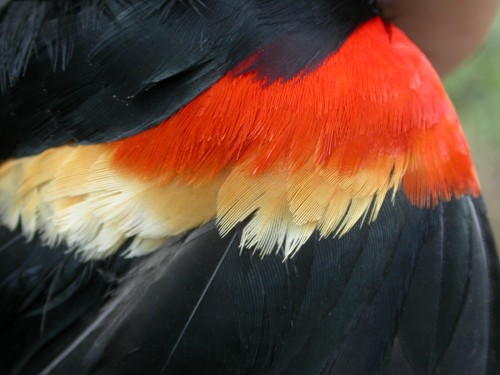
Photo by Marcel Gahbauer,
McGill Bird Observatory (QC), May 2006
Tails
are not generally useful in ageing or sexing blackbirds.
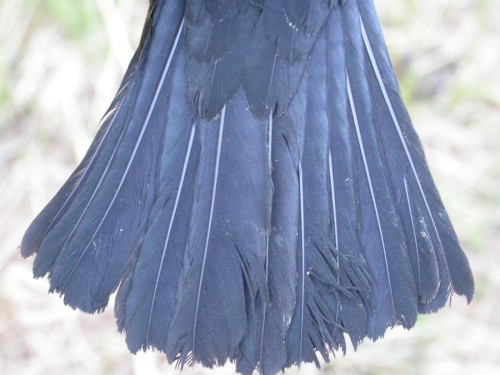
Photo by Marcel Gahbauer,
McGill Bird Observatory (QC), May 2006
RETURN TO AGE/SEX
OVERVIEW
|
JAN - JUL: after-second-year
female |
Always
be sure to measure the wing, as there are occasionally SY males that have undergone an unusually limited moult and closely resemble females. Any female-looking bird
with a wing measurement of over 112-113mm is not a female! ASY females
are streaked brown and white and usually have significant amounts of pink/salmon
in the face and throat. Older females may have a significant amount of red on the shoulders, as shown in some of the examples below.
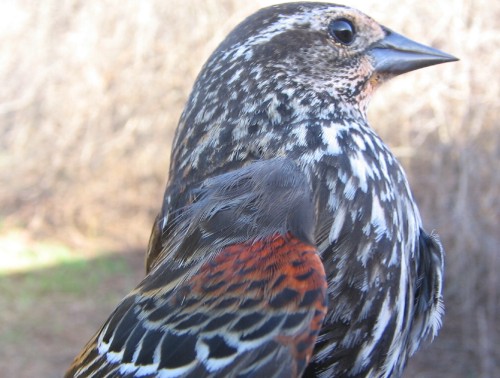
Photo by Marie-Anne Hudson,
McGill Bird Observatory (QC), April 2006
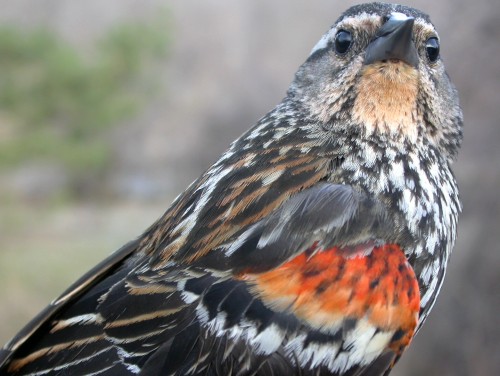
Photo by Marcel Gahbauer,
McGill Bird Observatory (QC), May 2006
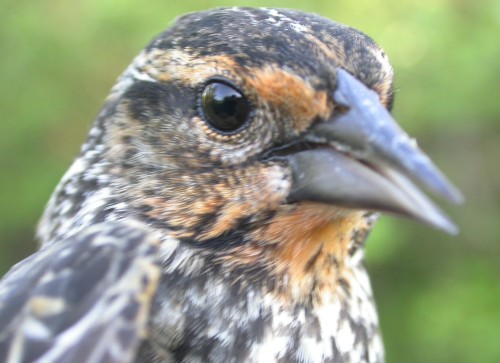
Photo by Marcel Gahbauer,
McGill Bird Observatory (QC), April 2006
ASY
females often have quite a bit of rusty edging in the shoulder. More
importantly, there is no contrast between the greater underwing coverts
and the adjacent feathers (shown below). Also note the quality of the
underwing coverts. There is very little wear, indicating an older bird.
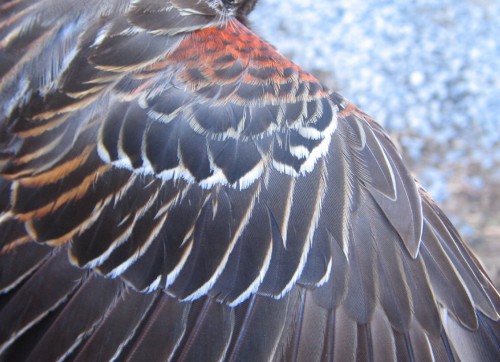
Photo by Marie-Anne Hudson,
McGill Bird Observatory (QC), April 2006
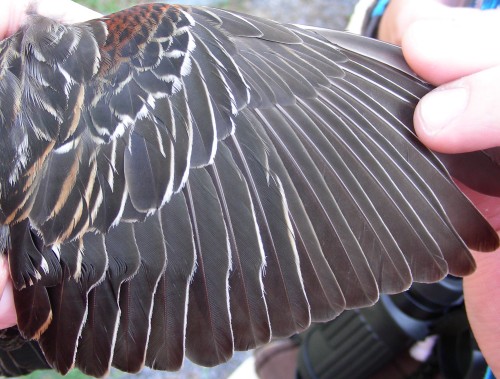
Photo by Marie-Anne Hudson,
McGill Bird Observatory (QC), May 2008
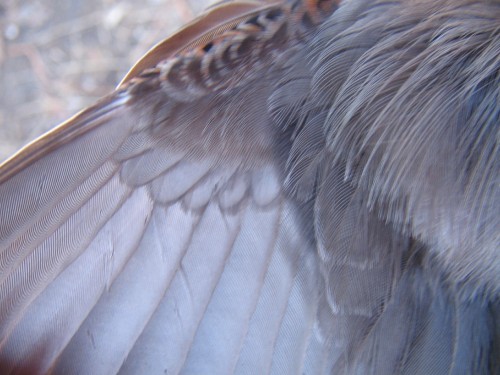
Photo by Marie-Anne Hudson,
McGill Bird Observatory (QC), April 2006
Tails
are not generally useful for ageing blackbirds.
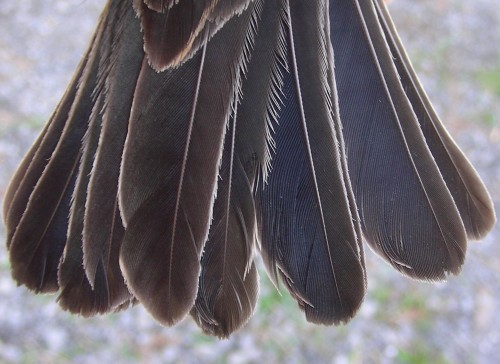
Photo by Marie-Anne Hudson,
McGill Bird Observatory (QC), May 2008
RETURN TO AGE/SEX
OVERVIEW
|
JAN - JUL: second-year
male |
Always be sure to
measure the wing: there are SY males that may closely resemble females (e.g. third photo below). Any female-looking
bird with a wing measurement of over 112-113mm is actually a male! SY
males are blackish with variable amounts of beige scalloping. As seen
in these 3 photos, this variation can be quite significant.
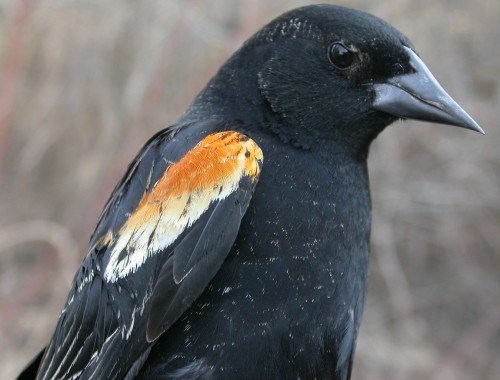
Photo by Marcel Gahbauer,
McGill Bird Observatory (QC), April 2006
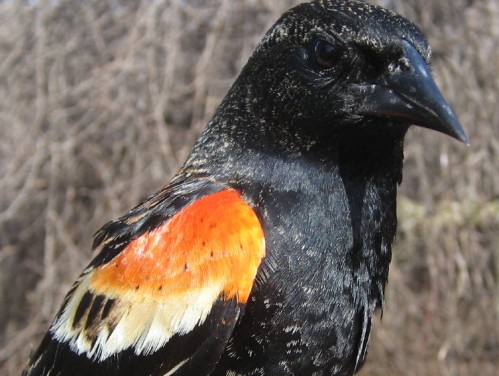
Photo by Marcel Gahbauer,
McGill Bird Observatory (QC), April 2006

Photo by Barbara Frei,
McGill Bird Observatory (QC), May 2007
The epaulettes, or
shoulders, are usually orange and yellow on second-year males and are spotted with black.
The underwing coverts should show a contrast
between the greater underwing coverts and adjacent feathers. Note that occasionally, as in the second example below, it appears that some brown juvenile feathers are retained among the primaries and/or secondaries.
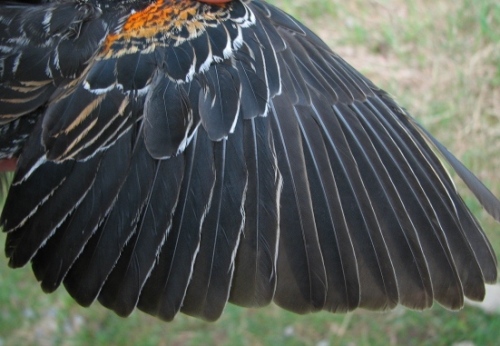
Photo by Barbara Frei,
McGill Bird Observatory (QC), May 2007
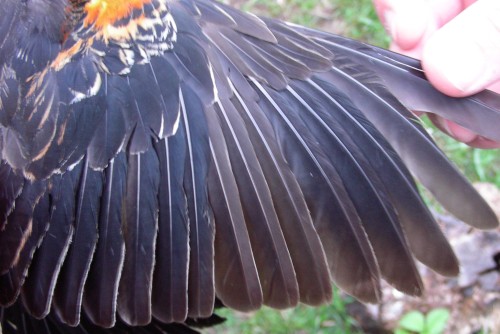
Photo by Marie-Anne Hudson,
McGill Bird Observatory (QC), May 2008
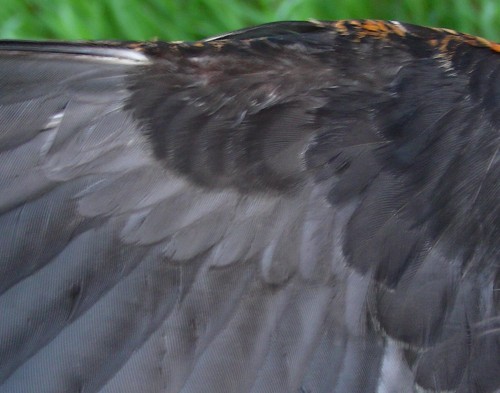
Photo by Marie-Anne Hudson,
McGill Bird Observatory (QC), May 2008
Tails are not generally important in ageing blackbirds.
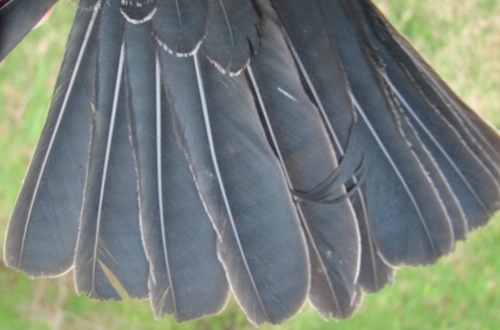
Photo by Barbara Frei,
McGill Bird Observatory (QC), May 2007
RETURN TO AGE/SEX
OVERVIEW
|
JAN - JUL: second-year
female |
SY
females are, as with most species, the least colourful form, sporting
brown and white streaked body plumage and very little to no colour in
the shoulder, face or throat.
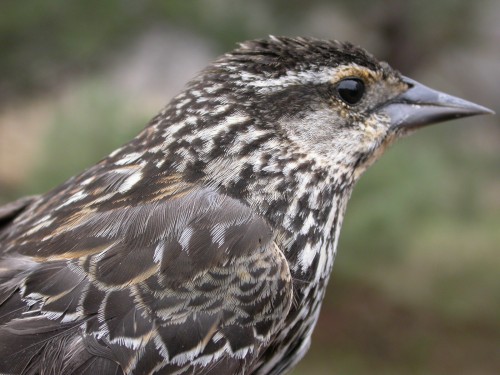
Photo by Marcel Gahbauer,
McGill Bird Observatory (QC), April 2006
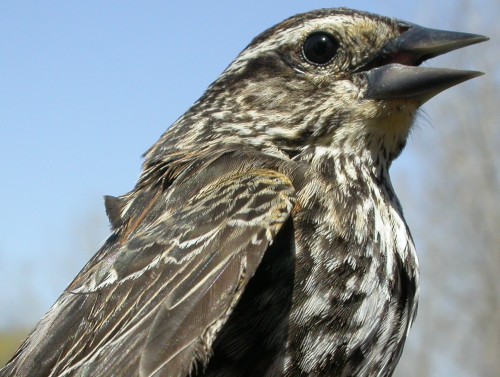
Photo by Marcel Gahbauer,
McGill Bird Observatory (QC), April 2006
The
underwing coverts should show a contrast between the greater underwing
coverts and adjacent feathers.
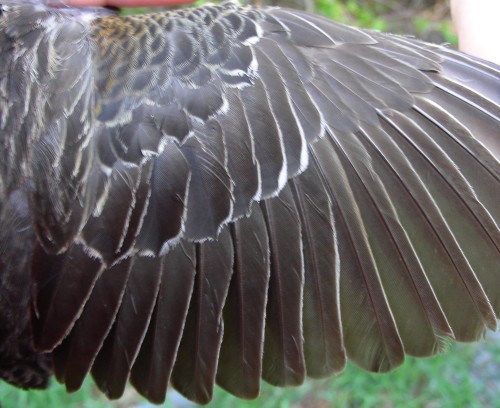
Photo by Marie-Anne Hudson,
McGill Bird Observatory (QC), May 2008
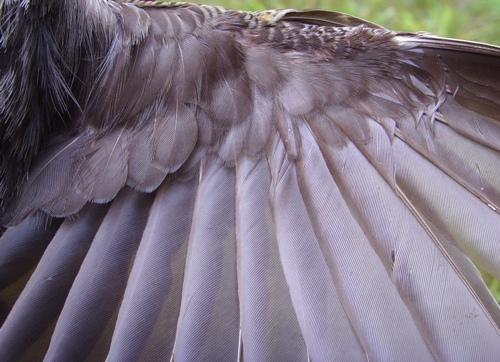
Photo by Peter Pyle, Merrylea (IN), May 2007
Tails
are not generally useful for ageing blackbirds.
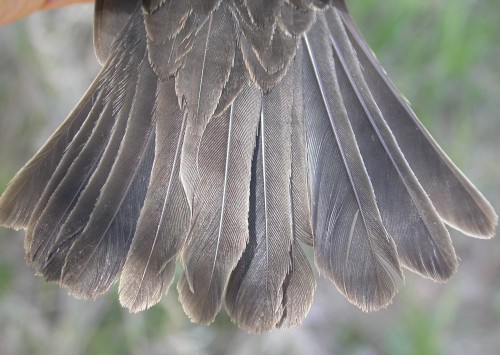
Photo by Marcel Gahbauer,
McGill Bird Observatory (QC), April 2006
RETURN TO AGE/SEX
OVERVIEW
|
JUN - DEC: after-hatch-year
male |
AHY males are
usually black with brown-edged feathers.
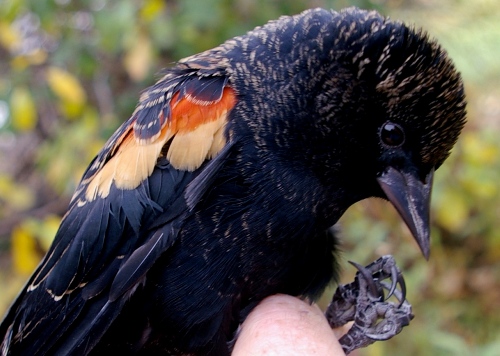
Photo by James Junda,
McGill Bird Observatory (QC), October 2008
The epaulettes, or shoulders, are solid, bright red/orange
and yellow. Also, there should not be any
contrast within underwing cover tracts.
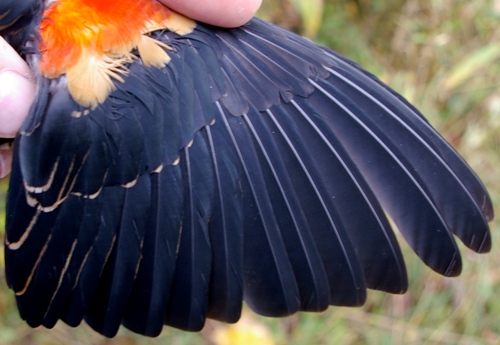
Photo by James Junda,
McGill Bird Observatory (QC), October 2008
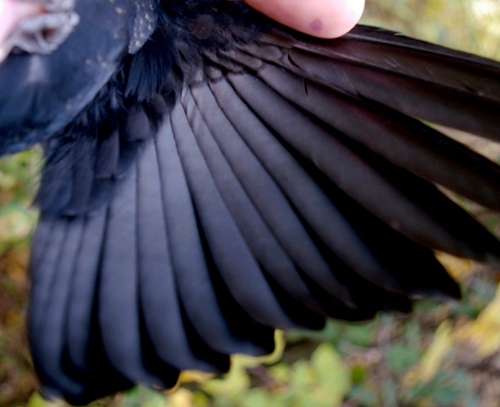
Photo by James Junda,
McGill Bird Observatory (QC), October 2008
Tails are not generally useful for ageing blackbirds.
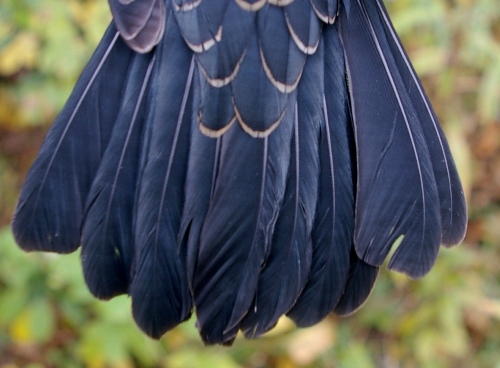
Photo by James Junda,
McGill Bird Observatory (QC), October 2008
RETURN TO AGE/SEX
OVERVIEW
|
JUN - DEC: after-hatch-year
female |
AHY females are streaky white and brown plumage with
rusty-edged epaulettes and may have a faint orange/salmon wash around the face and
throat, though some (such as the example shown) are quite pale.
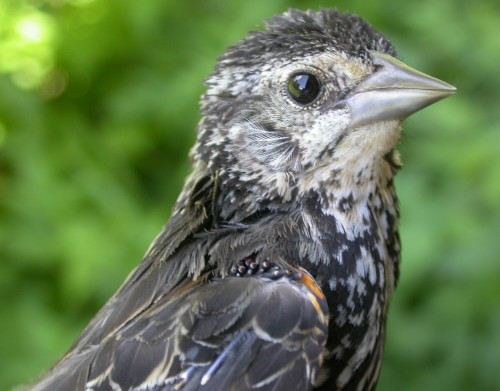
Photo by Marcel Gahbauer,
McGill Bird Observatory (QC), July 2006
AHY females often have quite a bit of rusty edging
in the shoulder. Also, there should not be any contrast between the
greater underwing coverts and adjacent feathers.
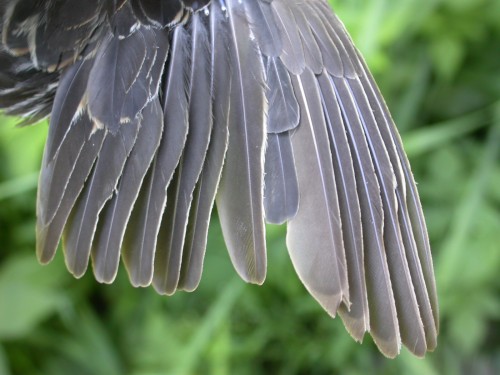
Photo by Marcel Gahbauer,
McGill Bird Observatory (QC), July 2006
Tails are not generally useful for ageing blackbirds.
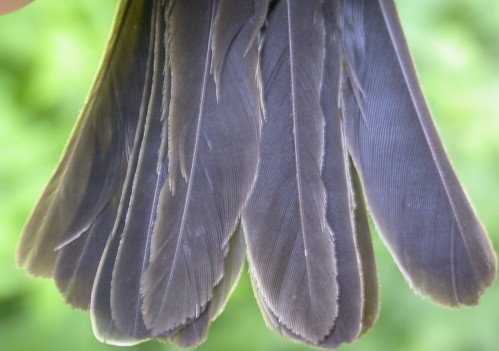
Photo by Marcel Gahbauer,
McGill Bird Observatory (QC), July 2006
RETURN TO AGE/SEX
OVERVIEW
|
JUN - DEC: hatch-year
male |
Always be sure to
measure the wing, as young males can resemble females. Any
female-looking bird with a wing measurement of over 112-113mm is not a
female! HY males after their prebasic moult have blackish body plumage
with variable amounts of beige scalloping throughout. As the
prebasic moult may complete fairly late in fall, be sure to also
consider juvenile plumage.
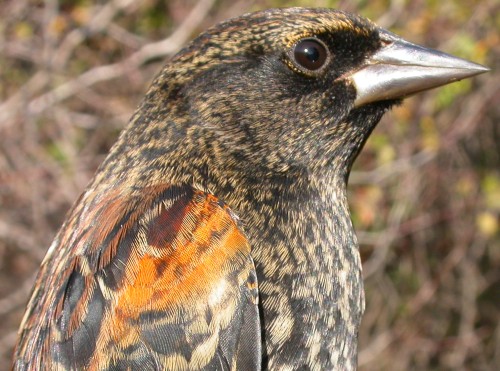
Photo by Marcel Gahbauer,
McGill Bird Observatory (QC), October 2006
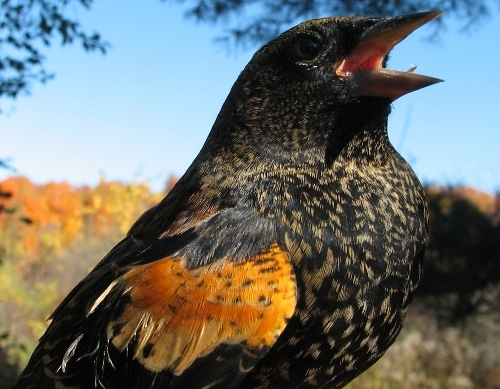
Photo by Barbara Frei,
McGill Bird Observatory (QC), October 2007
The epaulettes, or shoulders, are usually orange with yellow
and are spotted with black. The underwing
coverts should show a contrast between the greater underwing coverts and
adjacent feathers. Note that occasionally (as in the second photo below) some brownish juvenile secondaries or even primaries may be retained, and contrast conspicuously with adjacent black adult feathers.
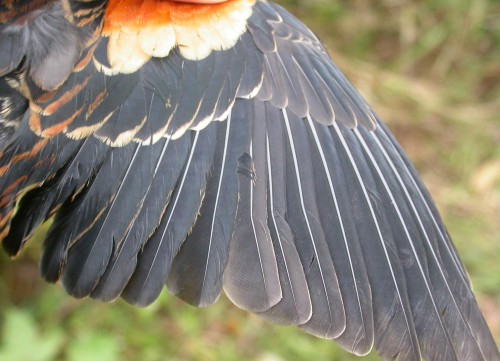
Photo by Marcel Gahbauer,
McGill Bird Observatory (QC), October 2006
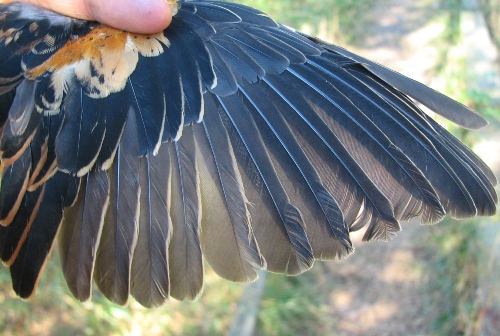
Photo by Barbara Frei,
McGill Bird Observatory (QC), October 2007
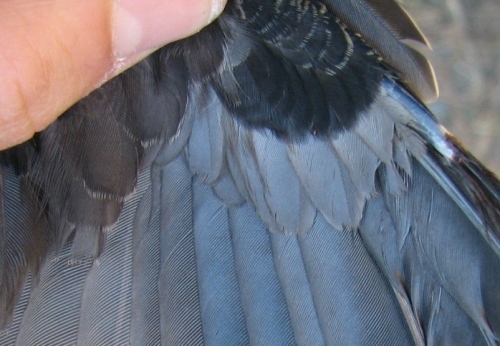
Photo by Barbara Frei,
McGill Bird Observatory (QC), October 2007
Tails are not generally useful for ageing blackbirds. The photos below show the undertail and top of a typical hatch-year tail.
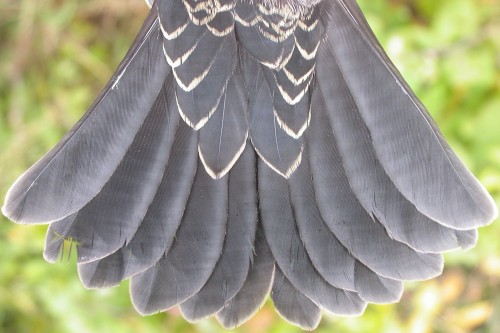
Photo by Marcel Gahbauer,
McGill Bird Observatory (QC), October 2006
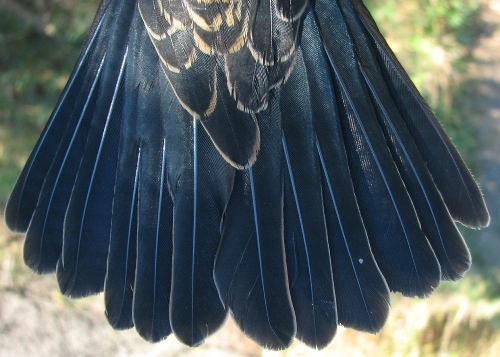
Photo by Barbara Frei,
McGill Bird Observatory (QC), October 2007
RETURN TO AGE/SEX
OVERVIEW
|
JUN - DEC: hatch-year
female |
HY females are streaky white and brown with little to no colour in the
epaulettes. Beware that HY males prior to their preformative moult may appear similar, though they can usually be
distinguished by wing length (males > 112 mm). See also the
juvenile account below.
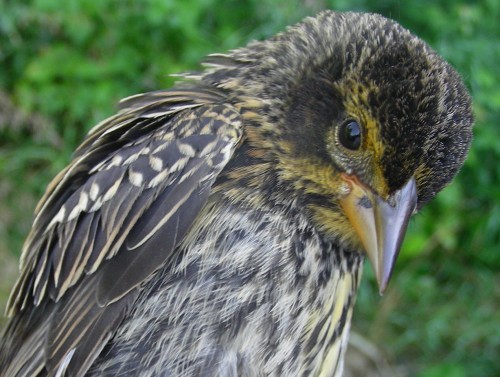
Photo by Marie-Anne Hudson,
McGill Bird Observatory (QC), August 2007
The underwing coverts should show a contrast
between the greater underwing coverts and adjacent feathers.
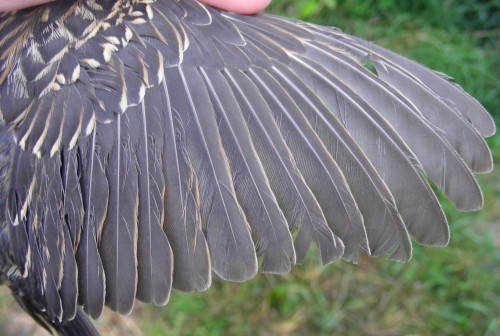
Photo by Marie-Anne Hudson, McGill Bird Observatory (QC), August 2007
Tails
are not generally important in ageing blackbirds.
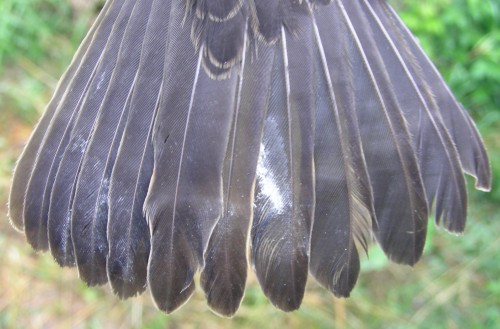
Photo by Marie-Anne Hudson,
McGill Bird Observatory (QC), August 2007
Juveniles of both sexes
are brown and heavily streaked, much like HY/SY females. If the
wings are fully grown, their length can be used to identify the sex of
most individuals (females < 107 mm, males > 112 mm; uncertain if between
108 and 111).
The wing is likely to uniformly brownish for most juveniles..
Tails
are not generally important in ageing or sexing blackbirds, but juveniles may have somewhat thinner and more pointed rectrices than older blackbirds.
RETURN TO AGE/SEX
OVERVIEW